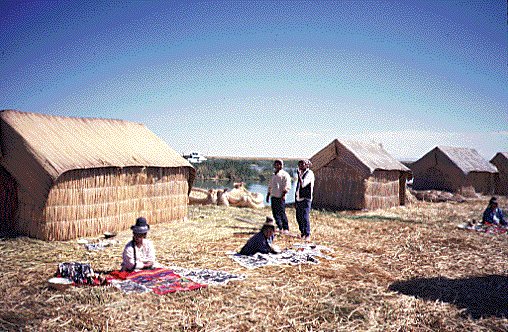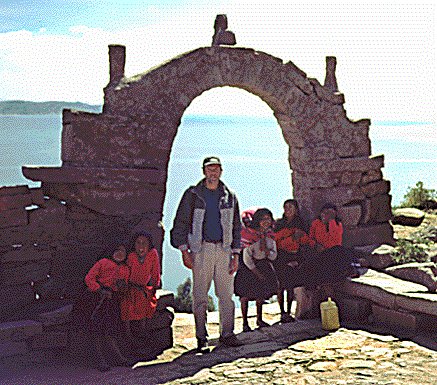Lake Titicaca is known as the world highest navigable lake, at an altitude of approximately 12,000 feet. The lake is also the largest in South America, with a length of over 170 kilometers. The main cities located on the shores of this large lake are Copacabana, Bolivia and Puno, Peru. I had the opportunity to visit both of these cities for a short period of time.
PUNO
Before my trip, I was warned by another traveler that Puno was a pit and a low point in her travels. I found the city a bit drab, and the city definitely pollutes their portion of the Lake, but otherwise Puno was very interesting. I had a hotel close to the rail station, about one-half block from the central market. My major adventure was an all-day trip on Lake Titicaca which included visits to the Floating Islands and Taquile Island. On my first evening in Puno, I left my hotel to find a restaurant and immediately found a street parade in process. This parade featured local residents dancers dressed in their traditional holiday costumes. Many bands were included in the parade, playing traditional Andean instruments and some typical brass band parade instruments. Most spectacular were the masks worn by many of the paraders, which seemed like a cross between an Asian dragon dance and wild, outlandish Marti Gras costumes. The parade lasted for about one and one half hours. (Unfortunately, it was too dark at the time to get any photos).
Puno has a great pedestrian street running between the two main cathedrals with a good selection of shops and restaurants.
![]()
FLOATING UROS ISLANDS
The Uros Islands are located on Lake Titicaca in a lagoon outside the City of Puno. The Uros people live full-time on these floating islands. These islands are made from totora reeds which grow in abundance on the shallows of Lake Titicaca. Their islands are made entirely from these reeds thrown down to form a walkable platform. Walking along, each footstep you sink in about 4 - 6 inches, but never enough to get your feet wet. They also make their boats from these reeds and much of their homes. As tourist excursions visit the island, the locals set up their craft displays in two long lines on the reed surface. Tourists run this gauntlet of merchants and frequently buy their local crafts.

Uros Indians on the floating islands selling their wares - reed boats in the background
![]()
TAQUILE ISLAND (Isla Taquile)
Visiting this island was one of the highlights of my Peruvian trip, although I spent only about a few hours on the island. It was a long, three hour boat ride from Puno to Taquile Island. Once on the island, you immediately have to climb over 500 stone stairs to reach the first village (remember, you are at 12,000 feet elevation).
The Quechua Indians who live on the island have maintained their communal and traditional lifestyles. Clothing is very traditional, with the men wearing coarse cotton woven shirts and calf-length black woolen pants. The women wear shawls which are black if they are married and red if they are single. Men also wear different color stocking caps if they are married or single. All residents of the island are vegetarian, and fish from the Lake are their main food source. Women are associated with fertility, and usually tend the agricultural fields. Men on the other hand, usually stand around in small groups and knit hats and gloves in the traditional style, which they sell in the village cooperative. Ten percent of the price goes to the village.

The author poses with schoolkids at the top of the stairway on Taquile Island
Copacabana, Bolivia & the Island of the Sun (Isla del Sol)
Copacabana, Bolivia is a short, 4 hour bus ride from La Paz. I rolled into town in the mid-afternoon, and immediately found a hotel - the most economical of my vacation - $ 4 US with a private bath with shower.
I went down to the waterfront and and just barely had time to buy my ticket for a boat excursion to Isla del Sol, the Island of the Sun. This island is famous for being the birthplace of the first Inca, Manco Capac, in the 12th century. I caught the last, afternoon boat to island. The trip was 2 hours on the lake each way, with only an hour to explore the Island of the Sun. I was able to climb to the top of the island, snap a few pictures and turn around to catch the last boat back.